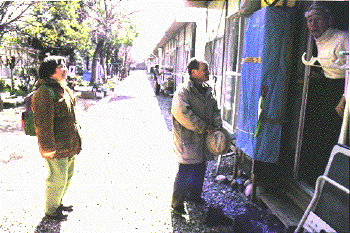
Volunteers visit the elderly living in temporary housing units. (Photo: Jiji Gahosha Inc.)
NONPROFIT ORGANIZATIONS:
Expanding Activities, Increasing Participation
JANUARY 21, 1997

Volunteers visit the elderly
living in temporary housing units. (Photo: Jiji Gahosha Inc.)
A heightened spirit of volunteerism in recent years has triggered an explosive rise in the number of nonprofit organizations and the breadth of their activities. Estimates made by the Economic Planning Agency in the spring of 1996 indicate that about 85,000 such groups are at work today across the country in activities ranging from care of the elderly to environmental conservation.
Services for the Elderly
Social welfare is by far the most common goal of the nonprofit
organizations, with about 41% engaged in such work. A large number operate
institutions or provide bath or meal services for elderly people who are
bedridden or live on their own, and some compile braille editions of books
and provide sign language interpretation services.
In the city of Kobe, one group has been providing transportation for
elderly and disabled people forced to move to temporary housing units after
a major earthquake hit the city in 1995. Three times a week, the
organization's members, most of whom are homemakers, make the rounds of
these communities with three vehicles to take residents shopping and for
medical checkups.
The group also organizes gatherings once a week in tents it sets up near the units in the aim of alleviating the sense of isolation felt by many of the elderly who live on their own. The group plans to begin providing meal services for the elderly in the near future.
Assisting people with disabilities is another common goal. One group in the city of Tochigi, for example, has provided reading services for blind and bedridden people for the past 20 years.
The organization's main project is recording the contents of the city's newsletter, which comes out three times a month and carries local news and public announcements. Members divide the work of recording the newsletter and making copies on cassette for distribution to 80 people. The group has also begun undertaking various projects in response to the growing number of requests for recordings of books, magazines, and newspapers.
Working for People and the Environment
Education, culture, and sports is the second biggest area of
activity, with 10% of all groups falling into this category. A number of
organizations run institutions for children who have trouble attending
school, others operate youth sports clubs, and a number are engaged in
preserving cultural assets.
International exchange is the objective of another 10% of the nonprofit organizations. Some, like that in the following example, focus their efforts on helping foreign students or the foreign community in Japan, while others dispatch volunteers overseas to provide support for developing countries.
In the city of Nara, a relatively new organization recently opened a general information desk in a community center to answer foreign residents' questions on aspects of life in Japan. Members also give lessons in the Japanese language, meet with the children of foreign residents, and even help the children with their homework assignments. Unlike other organizations of this type, this one stands out for its philosophy of mutual respect of cultural differences and the participation of both Japanese and foreign volunteers.
Environmental conservation groups follow next. Organizations of this type are active in everything from recycling to cleaning up rivers and parks, protecting plants and wildlife, and conserving the natural environment. Finally, a fair number of nonprofit groups are involved in community matters, such as town planning, or grappling with such issues as consumer protection, women's rights, human rights, and maintaining peace.
The Rise of Nonprofit Organizations
According to the Economic Planning Agency's estimates, which were
made on the basis of surveys carried out by five local governments of
differing sizes, including Tokyo's Setagaya Ward and the city of Hiroshima,
the majority of these groups are small, with half having less than 50
members and annual budgets of less than 300,000 yen (2,600 dollars at 115
yen to the dollar). On average membership fees account for 40% of the
groups' income.
As many as 5 million people, fully 75% of them women, are active in nonprofit organizations, according to the National Council of Social Welfare. By age, 42% are between 40 and 64 and 29% are 65 or older. By occupation, 46% are full-time homemakers, 13% are unemployed, and 11% are self-employed. The figures reveal that the desire to contribute to society through volunteer activities is strong among women who have finished raising their children and retirees.
The growing participation in nonprofit organizations and volunteer groups reflects a widespread awareness among members of the public that involvement in activities outside the home is indispensable to the achievement of a better, more mature society. The government, for its part, has welcomed and encouraged this trend in the realization that it cannot provide an adequate response to all the public's varied needs.
During the recent extraordinary session of the Diet, the Liberal Democratic Party, Social Democratic Party, and New Party Sakigake (Harbinger) submitted a legislative bill to support the activities of nonprofit organizations by giving them the same status as legally established foundations, and eventually preferential tax treatment. The three parties hope to get the bill passed during the next ordinary session scheduled to convene in January 1997.